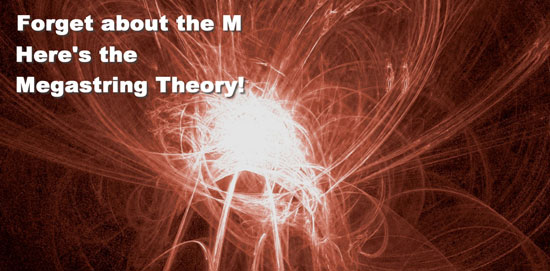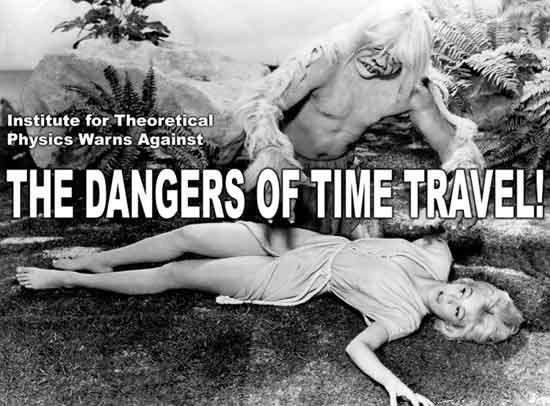
Newton got you down? Did Einstein get into your brain like sand in your swim trunks? Are you tired of the same old, day-to-day physics of string theory, M-theory, and the intensely adjectival super-string theory? Throw those theories in the dustbin and look no further! Megastring theory is here to take your physics to the next level.
Megastring theory is not for the faint-of-heart. It’s not for the weak-willed or the past-their-prime. Megastring theory is not on the path to the theory of everything. Oh no. Megastring theory is the theory of everything, the Holy Grail of Physics. Let me tell you how you can tap into the awesome power of Megastring theory. There are no complicated equations here, just eleven easy steps to Universal understanding. Are you ready to dive into the rest of your life? Let me tell you how.
1. Space is not just multi-dimensional, pan-dimensional or other word then dash dimensionals. In fact, it consists of exactly 1,409 spatial dimensions, 13 temporal dimensions, and four dimensions of a consistency with over-cooked spaghetti. These dimensions are not folded up. In fact, they can be found in an old cigare box in Mortimer J. Jacobson’s basement. Most smell of fresh apricots, though at least two could be considered more of a dried plum.
2. Most of these dimensions are inhabited by what looks like, and in fact is, stupid pudding. Also, there are eels there. The eels eat the pudding and then excrete gravity. What holds you to the Earth is hyperspatial eel poop. It’s a fact.
3. The 695th dimension consists entirely of a two-fingered old woman with no name. Two comical gnomes constantly antagonize her: Shortimer and Flango. Shortimer and Flango are always trying to steal the vast cold-cut and sliced-cheese spreads the anonymous woman has put out for her dinner guests who never arrive. These guests do not arrive because they learned early on that there were no cold-cuts or sliced-cheeses when they arrived. Though the old woman attempts to stop them, Shortimer and Flango invariably outsmart her and all the cunningly complicated traps she lays for them. In fact, they are only cunning by comparison to members of her species with one finger because her specie’s brain is located within each of the digits of its hand. The interaction between the woman and the gnomes creates meta-friction which produces the pudding people mentioned in point #2. When Shortimer sneezes, it creates the weak nuclear force. When Flango breaks wind, it creates the strong nuclear force.
4. All pudding people, eels, gnomes, and old women exist because of the interaction of a pot and a kettle in the 501st dimension. As each goes back and forth calling the other black, the other beings are maintained via the interaction of the pot and kettle’s negritons, allowing the gnomes to exist.
5. Made of marble, the 45th dimension is covered in cheese which is often smacked by a hammers wielded by tiny elephants. The cheese, thus stricken, vibrates, producing ventricles, or the particles apparent in lower dimensions such as ours. This is also where Madam No-Name Two-Fingers gets the cheese for her platters. The tiny elephants are not pleased about this, but being so tiny there is very little they can do about it.
6. Electromagnetism is there also.
7. Gravity, electricity, and the strong and weak nuclear forces are all mixed in a bowl and stirred regularly by Isis, who is mayor of the 1000th dimension. They are slowly poured into our dimension, which has already been greased around the edges, but not before mischievous, sentient catamarans decide to inject magnetism into the mix, much to the bedevilment of Isis.
8. The universe came into being because of the above mentioned things.
9. Once Flango and Shortimer eat all the cold-cuts, all the electromagnetic forces in the universe will begin to flow upside down, and the strong nuclear force eventually disappears.
10. Because the cause of Flango’s sneezing was actually a reaction with the extra-dimensional pepper molecules found in Shortimer’s flatulence as a result of his consumption of cold-cuts, the weak nuclear force will also eventually disappear.
11. CAUTION: Should gravity for some reason invert someone should go to Mortimer J. Jacobson’s basement and shake the cigar box. Not too hard, though. That should right everything and help recharge the universe. Do it a bit to the left, too, as I’d like to wake up perpetually to the smell of strawberries.
And that’s it. The universe in a nutshell. Megastring may seem complex or counter-intuitive, but remember that it has ten times more empirical evidence for it than super string does. 10 times zero is still zero.





